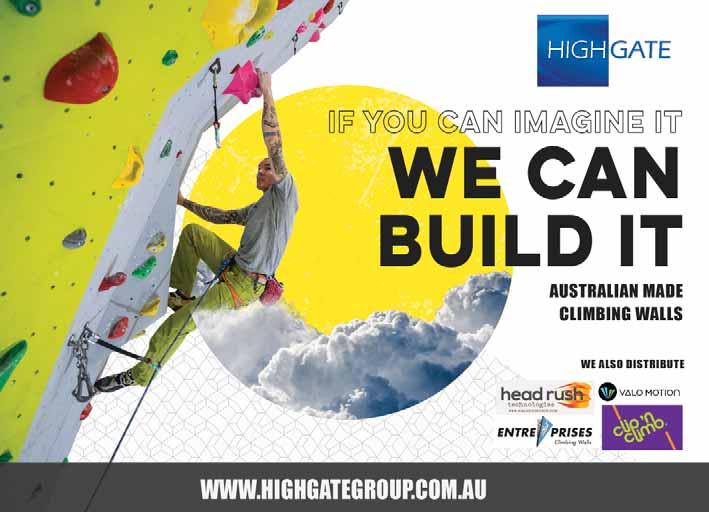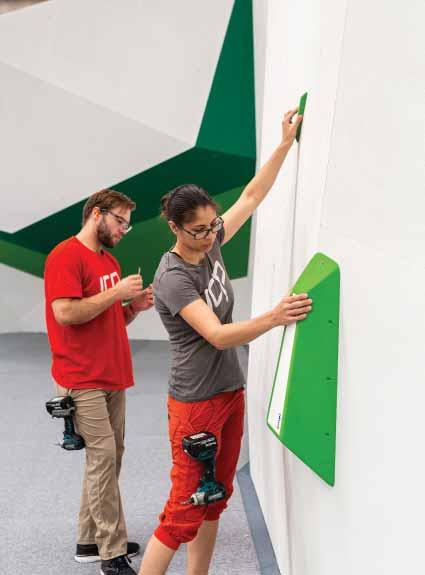
9 minute read
Sport Climbing set for Rapid Ascent


Advertisement
Entr-Prises wall from The Highgate Group. The Crux bouldering gym in Coburg North (top) and Flow Climbing on the Sunshine Coast.
James Croll examines the status of sport climbing in Australia following the success of the Tokyo Olympics and the impact on the sport’s venues, product development and growth
Of the five sports that made their debut at the Tokyo Olympics, it was sport climbing that probably had the most impact. Apart from the drama of the competition itself, the sport provided a wonderful spectacle with blaring music and strobe lights accompanied by a backdrop of a massive 20 metre high Gundam anime robot.
The event’s triathlon-style format, where climbers needed to perform in each of the three disciplines - speed, boulder, and lead climbing - initially drew some criticism but, as it was, the format packed in a lot of entertainment and finally showcased one of the fastest growing sports to the world.
Leading up to the Olympics, organisers had been encouraged by the growing number of indoor climbing gyms and a surge in the sport’s popularity. The 2019 Oscar winning documentary ‘Free Solo’ about Alex Honnold’s exhilarating climb up El Capitan in Yosemite National Park in the USA had also undoubtedly provided a wonderful pre-curser to the event.
Sport climbing’s triathlon format at the Olympics meant that each athlete was obliged to participate in all three of the sport’s disciplines - speed, boulder, and lead climbing. In speed climbing, two athletes compete against each other by racing to the top of a 15-metre wall while secured to safety ropes. Bouldering involved climbers - without safety ropes - individually trying to negotiate as many routes as they can on a 4-metre-high wall within four minutes. In lead climbing athletes sought to climb as high as they can up a 15-metre-high wall within six minutes, again using safety ropes.
Commenting on the format, Rob Parer of Brisbane-based ICP Climb, one of Australia’s leading specialists in climbing wall design, construction and safety, advised “the Tokyo 2020 format no doubt would have unsettled a number of athletes at first.
“While it was not the most conventional format it did manage to pack in a lot of entertainment and did certainly showcase our sport to the world. I do believe athletes will welcome a revised format in Paris 2024 when they will split up the disciplines.”
Considering the implications of the discipline’s success in Tokyo 2020 for the sport in Australia, Parer comments “our Australian athletes really did shine on the Olympic stage and have brought back a wealth of knowledge which will not only help prepare for the Paris Olympics but knowledge that will prove invaluable to Australia’s future Olympic climbers.
“What’s more, at ICP Climb we have already seen several climbing centres reach out to us wanting to grow their facilities. They’ve realised the need to upgrade to provide world-class walls, holds and safety matting for their local athletes so that they can become comfortable with international products and competition route setting.
“That said, to see a strong gain in performance we need the support of government to build some world-class training facilities and back our climbing athletes like many of the European countries do.”
Todd Austin of the Highgate Group, one of Australia’s leading




Climbing wall at Arcadia College on the Gold Coast. Equipped by ICP. Clip ‘n Climb from The Highgate Group.
designers and manufacturers of climbing walls, not just to the recreational and professional sector, but to the Australian Defence Force, agrees.
Austin notes “climbing in Australia is in its infancy (and) in all honesty, there are no competition grade speed walls or other competition facilities in the country at all and any serious climber has to train overseas. It would be great to see government support to assist our athletes.”
However, Austin is encouraged by the noticeable growth of the sport at grassroots level particularly in schools, stating “we’re not only experiencing a significant increase in demand to design and install walls at schools but a rise in demand from boutique climbing venues looking to accommodate teens by way of far more imaginative and creative environments.
“Kids and teachers are realising that climbing isn’t just a test of strength and agility, but a fabulous test of problem solving. This is particularly relevant when it comes to bouldering as the discipline calls upon the climbers technical and tactical expertise as they try to negotiate the routes in as little time as possible. Few other sports can compete with climbing in providing a combined physical and mental challenge. What’s more, it’s apparent that teens aren’t just wanting to experience the stimulation of climbing itself but are wanting to experience it in an exciting and social environment.”
Action-packed and visually stunning The Highgate Group is ideally positioned to satisfy that demand
Entr-Prises’ Mozaik from The Highgate Group. as they design and manufacture a range of highly diverse walls.
Austin notes “at Highgate we can design climbing walls from simple plywood construction through to fully modular fibreglass ‘real rock’ surfaces.
“We’re the exclusive Australian distributor for Entre-Prises climbing systems which is proving particularly popular in recent years with 6,000 climbing wall projects across Europe, the US and China.”
Highgate supplies and installs two of Entre-Prises climbing systems to the Australian market - the Freeform Sculptured Rock and Mozaik Striking Designs. The Freeform Sculptured Rock-climbing wall is particularly striking; it is 100% hand formed; custom made climbing wall which recreates the look of natural rock. It is flat with high density handhold locations and Highgate can recreate any rock formation, feature or style of climbing.
However, the Clip ‘n Climb concept is probably the most exciting concept for the youth market.
Austin adds “Clip ‘n Climb is the most exciting new concept in indoor climbing to have emerged in the past decade.
“It is stunningly visual and has been designed to be actionpacked with individually themed climbing challenges for everyone from primary school kids to ‘recycled’ kids. It was developed to encourage non-climbers to give it a go in a safe but fun environment. Conventional indoor climbing gyms are great for the experienced and technically minded climber but not always as appealing to the non-climbers, especially young ones. By creating an arena full of colourful and clearly different climbing challenges it encourages non-climbers to give it a go. It is incredibly popular with families, friends, schools, youth groups, sport teams, work socials and corporates alike. There is also no minimum or maximum age. Participants are encouraged to test their resolve and determination while climbing commando style on the Jungle Gym, reach new heights on the Skyscraper, take the Speed Climbing challenge or light up the board on the Checkerplate. There’s even an ultimate challenge - the Leap of Faith.”
In a similar vein, the recently opened The Flow bouldering gym at Forest Glen on the Sunshine Coast is already welcoming a range of first-time climbers in addition to its more adventurous climbers.
Developed and built over the past three years, General Manager James Hembury and his partner and Operations Manager Angel Freeman developed the facility having climbed and worked in gyms all over the world.
Henbury explained “we wanted to bring what we found in various places around the world to the Sunshine Coast and that’s why we’ve made The Flow.
“There are over 50 problems to suit all abilities, from highly experienced climbers to first-timers.
“Every angle and every feature have been checked carefully


Route setting by members of the ICP team.
to give climbing space with the best holds available which are regularly updated by an experienced team of route setters.
“Our unique walls and experienced climbing coaches can help everyone climb better and upskill faster.”
Hembury said climbing incorporated a mental and physical challenge and that was no different inside the flow building, adding “each problem and every route you see on the wall is crafted so it requires you to figure out the problem, to solve it mentally and then to use your body to actually get through the route. Ultimately, we’re trying to make a space and a vibe where people can come and hang out regardless of whether they climb. Right now, it feels as if everybody involved knows somebody that climbs so we’re hoping to bring everyone together to make a proper climbing community.”
Explaining how the company equipped The Flow, ICP Climb Head of Design, Silvia Febres stated “the inspiration for Flow originally came from a bamboo farm - rows of bamboo flowing across a field, with shoots popping up out of nowhere.
“It was a real pleasure having a larger space to develop the project. It allowed us to use ICP’s high-quality walls and boulder matting to their full potential by building grand, flowing angles. It also gives more room for socialising, chilling out, and a yoga area.
“The daylight streaming in through skylights in the roof was also a big plus. It helps to make it feel lighter and brighter inside, giving the indoor environment a natural connection with the outdoors while really showing off the space.”
Safety The rise in popularity of climbing has of course led to an increased focus on safety. As a result, leading international climbing wall and active entertainment equipment manufacturer Walltopia has released a flooring guide for climbing and active entertainment facilities.
A perfect example of how valuable safety flooring is can be seen in the guide’s advice on flooring for indoor bouldering where it is mandatory in most parts of the world to put some impactabsorbing material underneath the artificial climbing structure.
The purpose of the impact-absorbing flooring for bouldering is to be able to accommodate landings to minimise injuries. The flooring solution can be an air cushion, shingle, or foam safety mat. Bouldering being the discipline where falling is a part of the sport, it is safe to say that these options are perfectly valid for high wall climbing and active entertainment facilities as well.
The most popular choice are foam safety mats. Simply put, a foam safety mat is several layers of foam encapsulated together in a fabric bag (PVC coated, polyester fabric, carpet, ballistic nylon, etc.). Customers can choose between ‘vinyl,’ ‘carpet,’ and ‘ballistic nylon.’ ‘Vinyl’ has been the most popular material of choice because of its elasticity and tensile strength but since it is hard to clean and does not hold the chalk, many users prefer ‘carpet.’ In fact, the best quality and results are achieved when using ‘vinyl’ and ‘carpet’ together since ‘carpet’ on its own can be brittle and exhibit inelastic deformation.
Dr Bozhidar Oreshkov, Head of Research and Development for Climbmat - one of the top manufacturers of flooring solutions for climbing gyms and active entertainment facilities - advises “all of our products are on the lower half of the deceleration (impact force) range, allowed by the European and Australian standards. However, to some climbers, even our softest mats could feel hard. Thus, alongside quantifying the forces experienced by climbers and minimising the possibility for injuries, we advise our customers to educate all climbers on proper ways of falling on boulder mats, to further minimise the chances for injury.” James Croll looks after Client and Partner Relationships for Australasian Leisure Management.
Innovation from Walltopia (and right).












